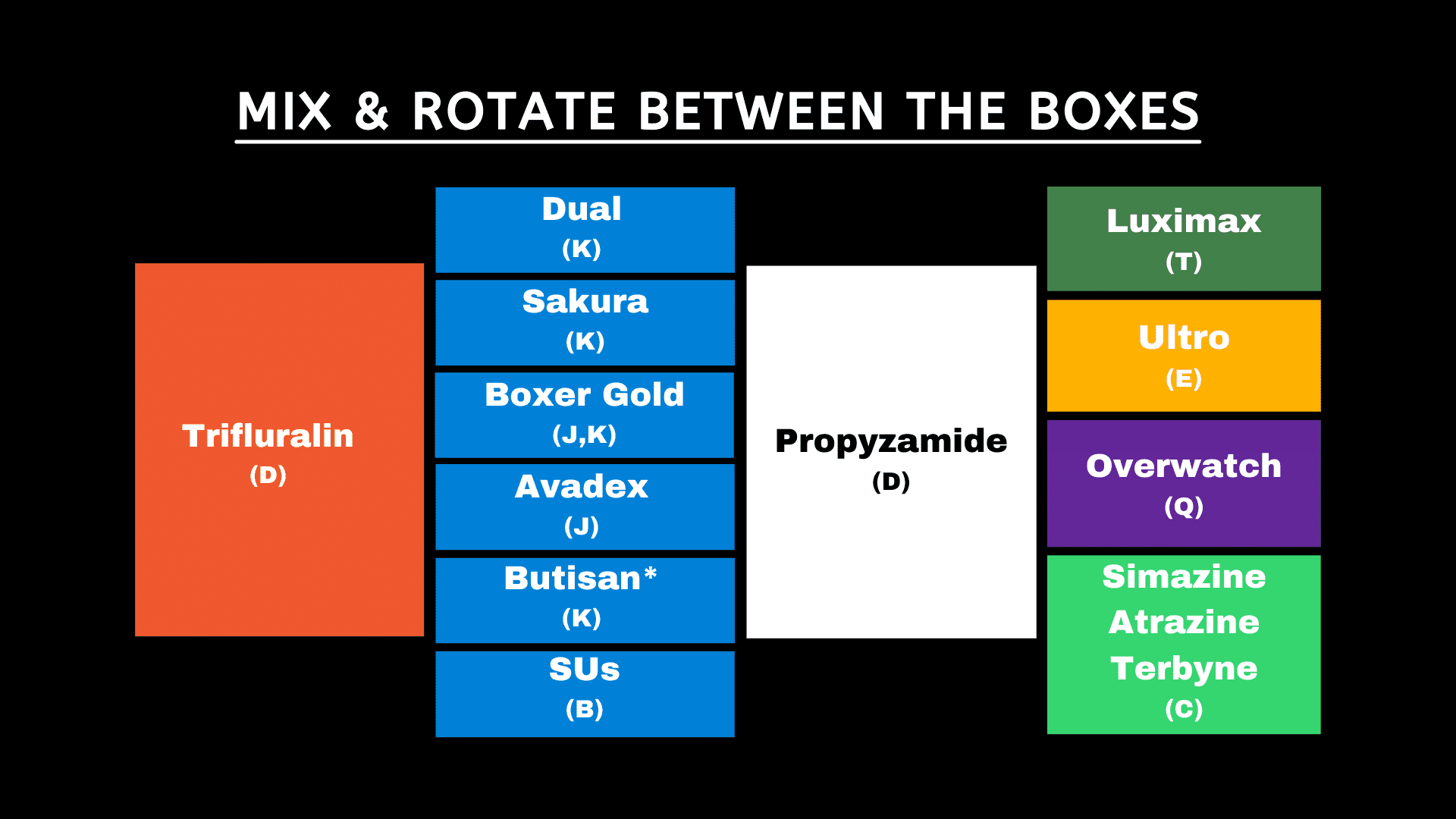Ask a WeedSmart Expert
MIXING pre-emergent herbicide groups is known to extend the effective life of all the mixing partners, and is even more important than simply rotating herbicide modes of action.
Mixing can even breathe new life into herbicides that appear to have ‘run out of puff’.

Agrivision agronomist Tim Pohlner, Horsham, says it is important to keep as many options as possible ‘alive’ as viable tactics to use in a diverse program.
Agrivision agronomist, Tim Pohlner, says it is well worth the effort to review and fine-tune your pre-emergent and in-crop herbicide plan for the coming season and beyond to make sure you get the best bang for buck.
“Effective weed control underpins profitability and while doing a good job may cost more there are rewards in productivity and profitability in keeping weed numbers low,” he said.
“A robust pre-emergent mix has a two-fold benefit in providing early weed control while the crop is small, as well as reducing the pressure on in-crop herbicides.”
Some pre-emergent herbicides, such as trifluralin, are no longer an option as a standalone herbicide for ryegrass control, but can be a useful mix partner with other pre-emergent herbicides.
“It is important to keep as many options as possible ‘alive’ as viable tactics to use in a diverse program,” Mr Pohlner said.
“Herbicides can’t do all the work on their own and need the support of cultural practices as well.
“Mixing and rotating herbicide groups is one of the WeedSmart Big 6 tactics to reduce weed pressure and prolong the useful life of current chemistry.
“There is strong scientific evidence for the value of mixing pre-emergent herbicides whenever possible, provided all the necessary precautions are met.”
*Always read the label and check with your agronomist for compatibility before mixing and applying agricultural chemicals.
What’s a good pre-emergent strategy for wheat and barley?
In brief: Mix trifluralin with a partner for better weed control.
The details: Trifluralin is no longer an option as a stand-alone herbicide against ryegrass. Application rates increased over time in response to increasing resistance but the release of Boxer Gold and Sakura have offered alternative chemistry that partner well with trifluralin. Rotating compatible mixes prolongs the life of all the applied chemistries.
When trifluralin is applied on its own each year resistance is expected within 10 years. When trifluralin is rotated with other single-shot herbicides, the onset of resistance is delayed by another two or three years, but when trifluralin is mixed with other pre-ems, and the mixes are rotated, it takes 25 years for resistance to evolve, even though trifluralin is applied in two years out of every three.
Including trifluralin in a herbicide mix with Boxer Gold, Sakura or prosulfocarb broadens activity on more weed species and extends the length of control into the growing season.
Some tried and true pre-em mixes for cereals are:
- Boxer Gold + trifluralin IBS
- Prosulfocarb + trifluralin IBS
- Prosulfocarb + Sentry PSPE
- Prosulfocarb + Avadex IBS
- Sakura + trifluralin IBS
- Sakura + Avadex IBS
- Sakura + Sentry PSPE, disc system
- (Diuron can be added to all of the above)
Recently, several new pre-emergent grass herbicides have been released into Australia, providing additional rotate and mix options. Luximax (Group T / Group 33) was a new herbicide group to broadacre agriculture in 2020. Luximax is only registered in wheat and should be applied IBS in front of a knife point press wheel. BASF strongly recommends that the wheat seed has 3 cm of soil covering to minimise crop damage.
Overwatch is a Group Q (Group 30) bleacher being released this year. It has a very unique use pattern where it controls annual ryegrass and suppresses brome and wild oats, provides control for some of our hard to control broadleaf weeds and suppresses many others. Key broadleaf weeds are bifora, hog weed and sowthistle, and suppression of bedstraw capeweed, prickly lettuce and wild radish.
FMC promotes Avadex as an excellent partner mix. In extreme ryegrass populations, Overwatch + Sakura is very effective although pricey. Trifluralin is a good, cost-effective partner mix.
What is the best mixing strategy for break crops?
In brief: In break crops there are opportunities to mix pre-ems and then to use a mix of in-crop grass selectives.
The details: Widespread resistance to Group A (Group 1) herbicides has changed the way break crops are grown and made it essential to have a strategy in place for ryegrass control. In some situations, it may be worth considering growing a legume that allows a substantial knockdown e.g. field peas, chickpeas.
Mixing trifluralin with propyzamide improves overall grass control when applied pre-emergent and incorporated by sowing. Propyzamide can also be mixed with Simazine or Terbyne at robust rates.
Ultro is a new pre-emergent grass herbicide for pulses for 2021. Ultro is a Group E (Group 14) and will give a new option for ryegrass control and provides better control of brome grass and barley grass than many other pre-emergent options. Ultro has good water solubility, enabling good weed control even in marginal breaks to the season. Ultro can be mixed with most other pre-emergent herbicides.
In-crop, clethodim is still a cornerstone herbicide for grass control in break crops. To maximise effectiveness, avoid applying when the weather is cold or frosty, establish dense, competitive crops, use pre-ems to reduce weed pressure, apply robust rates and mix clethodim with Factor (butroxydim) or Intervix / Intercept over IT canola and XT lentils and beans. Implement crop topping prior to harvest to stop weed seed set in late germinating weeds.

Mix and rotate between the boxes for pre-emergent herbicide modes of action.
What makes a good herbicide mix?
In brief: Two or more compatible herbicides, each at full label rate for the target weed.
The details: Additionally, there should be no (or low) resistance to the individual herbicides in the mix, no antagonism between the herbicides, the products must be chemically compatible when mixed and the mix must be safe to the crop and cost effective.
The aim of the weed control strategy should be to target zero weeds. Make the most of the rotational options available in your growing region and use cultural practices as well as herbicides to reduce weed numbers.
Avoid rotating to an inferior product because that will inevitably result in a weed blow-out. However, don’t discount a herbicide even if you know the weeds present have a level of resistance. Mixing this less effective herbicide with another mode of action will often improve the outcome.
Mixing herbicides may increase production costs but you can be confident that the reduced weed burden will increase production and profitability. With a little forward planning it is usually possible to solve the majority of weed issues that are encountered.
The global classification of herbicide modes of action is changing. You can find out more on the Herbicide Resistance Action Committee website. https://hracglobal.com
Source: WeedSmart
……………………………………………………
How to ask a WeedSmart question
Ask your questions about about mixing and rotating herbicides on the WeedSmart Innovations Facebook page WeedSmartAU, Twitter @WeedSmartAU or the WeedSmart website www.weedsmart.org.au/category/ask-an-expert/



HAVE YOUR SAY